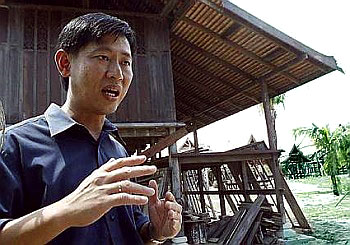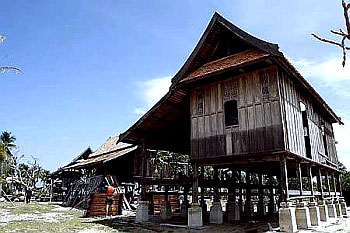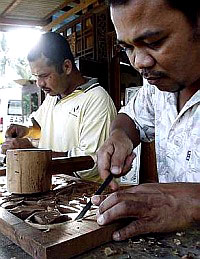|
|
Passion for preservation
House by house, one man is trying to save the rich architectural and cultural heritage of Terengganu. A GUY has been buying old wooden Malay houses from all over Terengganu for about RM10,000 each. He dismantles them, and then reassembles them into a boutique beach resort. And then he will charge tourists a few hundred ringgit for one night’s accommodation. Who says heritage does not make ringgit and sense?
This is Terrapuri, a project by Alex Lee, the boss of Ping Anchorage (go to www.pinganchorage.com.my), one of Terengganu’s largest tourism operators.“Conserving heritage buildings is like buying antiques. It may look like junk now, but its value will soar later,” he says. And in Penarik, about 90 minutes north of Kuala Terengganu, he is assembling his dream project, plank by plank. When completed later this year, it will feature 28 antique (between 100 to 200 years old) Malay houses in refurbished splendour and reassigned luxurious roles as a spa, an art gallery, a beach club, residential suites, and a Malay fine dining restaurant. Even by Terengganu’s high standards, the project sits on a breathtakingly beautiful site: a narrow spit of land flanked by the South China Sea on one side and an inland sea with mangroves and nipah palms on the other. By day, coconut trees sway amidst sea breezes and three of the state’s top island attractions – Redang, Perhentian and Lang Tengah – shimmer invitingly just offshore in emerald iridescence. By night, fireflies flash about while, in different seasons, ocean-going green turtles and fresh water river terrapins lay their eggs on their respective sandy shores. As if this symbiosis of architectural and ecological heritage is not rich enough, there will be artistic pedigree thrown in too: Chang Fee Ming, renowned for his luminous watercolours of traditional Terengganu villages and a personal friend of Lee, may have found the perfect setting for several of his artworks here – which will adorn the antique wooden walls of Terrapuri. (Chang’s latest KL exhibition, Mekong: Exploring the Source, was featured in StarMag’s Arts pages last week in An epic journey, captured.)
Losing charm Lee’s amazing journey began over 20 years ago when he used plywood partitions in his grandparents’ wooden shop at Marang, Terengganu, to create a backpackers guesthouse. “I learnt about the importance of heritage from my guests,” he recalls. Over the years, he has been buying up not only old houses but also everything inside them – from highly ornate quail traps and boat prows to coconut scrapers and cookie moulds. “Often people in the kampungs would just throw these old wooden things underneath their houses where they slowly rot away,” he says.
“Some wooden houses have been chopped up and modified with concrete renovations. Often people will say, ‘susah (difficult) to maintain’, yet in Sweden, they can maintain not only 600-year-old timber houses but also whole wooden towns. Our houses are only 200 years old! So why can’t we?” says Lee. One hard lesson was the tearing down of Marang old town (20km south of Kuala Terengganu) comprising wooden shops, including Marang Inn, Lee’s original backpackers’ lodge. “In the early 1990s, a kind of backpackers haven developed there. Eric Tho (the batik fashion exponent) started here, too, and he had roaring sales. And there was good business for food hawkers and souvenir stalls,” Lee says. However, when the then State Government saw the prospect for tourism, they decided to “clean up” the town by revoking the shops’ Temporary Occupation License land titles, demolishing the “old, ugly” wooden shops, and building “nice, modern” concrete ones. “Overnight, tourism in Marang was killed. When the heritage charm there was gone, the backpackers stopped going there,” recalls Lee. Examples of this mindset can be seen even in urban landscaping where Municipal Councils plant expensive, non-native date palms, or worse, plastic palm “trees”!
It’s not just endurance that’s embedded in the wood, it’s a whole cultural history. The book Spirit of Wood: The Art of Malay Woodcarving by Dr Farish A. Noor and Eddin Khoo (ISBN: 978-0794601034), has postulated that Terengganu is heir to the rich cultural legacy of the ancient Langkasuka kingdom (2nd to the 16th century CE, which may have been located on the east coast of Peninsular Malaysia) and thereafter the Sultanate of Pattani. Lee adds that the Terengganu Malays have also long had links with (and possibly originated from) the ancient civilisations of Champa in central Vietnam and Cambodia, and that many renowned traditional Malay art forms, including wayang kulit and dances like Mak Yong and Menora, hail from this area. And, of course, this fertile cultural milieu shows up in the houses. According to Lee’s research, the Terengganu traditional house known as rumah bujang berserambi, (stand-alone house with veranda) has features strikingly similar to Cambodian and Thai houses, such as a raised platform on stilts, a generally triangular shape, steep gabled roofs, gently curved gable ends, rhomboid-shaped terracotta roof tiles, and timber panel walls slotted into grooved frames. Amazingly, not a single nail is used. Instead, the whole structure is fitted together using wooden joints held in place by pasak (wooden pegs). “That’s why the whole house can be dismantled and put back together,” says Lee. “In our (Terengganu Malay) dialect, we call it masang, meaning ‘assemble’. Imagine, Terengganu was already making prefabricated homes hundreds of years ago!” When parts rot away, Lee commissions woodcarvers to do up fresh carvings. Most Terengganu woodcarvings fall into two categories: simpler kerawang, or geometric, designs or finer sobek with flamboyant filigree resembling local foliage. Lee takes some of his most precious antique carved panels out from a storeroom and goes to meet two woodcarving brothers near Kuala Terengganu, Amran and Abdul Rahim Ismail. One panel has swirling vegetation in timba balik or mirror image patterns. What does it all mean? “You see here two trees tied together and a flower coming out of their union. It’s like a synergy,” explains Amran. Another carving has an eight-sided floral pattern. “Even we carvers don’t really know the origins. It’s too ancient. It’s just that owners of old houses tell me it’s called pecah lapan (break into eight),” says Rahim. Lee thinks it’s a possible clue to cross-cultural fertilisation: “It could have originated from the bagua (an octagonal mirror) of Chinese feng shui. Or maybe it’s the Buddhist eight-fold path.” Apart from ancient architectural heritage, Lee also wants to emphasise the “Terengganu garden” concept with local trees such as jambu laut, bunga tanjung, and melinjau. “When I was growing up as a boy in Marang, I remember people used to have puja pantai (sea worship) ceremonies for up to three days. Hawkers would fry melinjau nuts in hot sand as snacks then. All that has disappeared in the last 30 years.” While some traditions have disappeared because they are perceived to be un-Islamic holdovers from Terengganu’s animist-Hindu past, Lee at least hopes that his guests can sample those fried melinjau nuts again. With such a bountiful heritage, Lee chose the name Terrapuri for his project – from terra, Latin for land, and puri, Sanskrit for palace. The Land of Palaces. Being the savvy marketing guy that he is, Lee smiles and adds, “It also refers to the river terrapins of the area”. Before he bought each home, he or his staff interviewed not only the owners but also the neighbours to ascertain its history. One of the homes was built by one Haji Mohd Ali some 150 years ago, and has the rags to riches story of a Terengganu-style Loh Boon Siew (aka Mr Honda, the Penang tycoon). Ali was a 19th century millionaire who made his fortune from trading in pelara (Terengganu fish sauce). Lee tells the story: “He would send out his boats to the big ships moored at Kuala Terengganu to buy salt from Siamese traders. Using that, he would ferment fish until it turned into pelara. Then he would go up the Terengganu River as far as Kuala Berang to barter for rice, fruits, and other jungle produce. From that, he made a fortune and built two big houses.” Ali’s grand old house will be converted – and will emit a more fragrant smell than fish sauce! – into a Malay-style spa, overlooking the inland sea of mangroves. “There are many Balinese and Thai spas but not many Malay spas being marketed. I have a pakcik from a kampung nearby training my staff in traditional Malay healing arts such as mandi bunga (flower bath) and urut (massage). Sound economics Lee, who speaks the Terengganu dialect of Malay fluently, says that heritage is not just about cultural pride for his home state. It’s also solid economics. “Traditional builders and craftsmen have been losing their jobs, as all the kampung folk now want concrete houses. Old skills are being lost. But conservation can become a whole industry in its own right, like in Europe. For instance, I have been employing several tukang kayu (carpenters) to reassemble and renovate the old houses.” And, of course, it will give Malaysia a crucial edge in the tourism industry. Under the Government’s East Coast Economic Region plan, Terengganu is supposed to become the “tourism hub” for the East Coast. “The airport will be upgraded but tourism is not just about infrastructure or about providing a beach hotel any more. You can find the same type of modern hotels the whole world over,” explains Lee. “Tourism is about content, and heritage is crucial. We face stiff competition from Thailand and Bali where the cultural tourism is stronger. As it is, unlike in Bali, it’s difficult to even catch a traditional Terengganu dance here unless it’s a specially organised event. “People will want to visit a place because of its unique heritage and culture, they want to see traditional houses.” He says there has been “not much” Government financial support for conservation, and he has had to self-finance his project. “It’s not cheap, and commercial loans have higher interest rates. Conservation is a long-term investment. But once we have saved it, the money is bound to come in later.” Despite lack of Government backing, Lee has been more than willing to pour his time, energy and money into his Terrapuri heritage project. “If I just wanted to make fast money, I could have built an eco-themed resort very quickly. This has been like my hobby.” It is indeed a testament to ethnic harmony when Lee, who is Chinese-educated, is taking a leading role in promoting and preserving Terengganu’s Malay heritage. “My grandmother is a Terengganu Peranakan Chinese. She used to wear a sarong and eat dishes like laksa with budu (Malay fish sauce).” And Terrapuri, Lee’s labour of love, is perhaps a much more eloquent testimony of Bangsa Malaysia pride than any seminar or slogan could ever be. Next week: Malay feng shui from Terrapuri and beyond.
|



